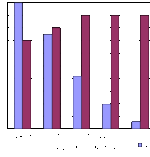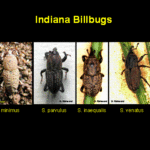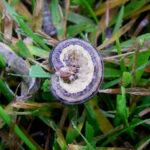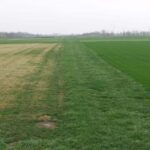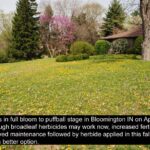Turf Tips Archives
How Late is Too Late to Control Dandelions and Other Weeds?
Even though the drought has limited some broadleaf weed applications this month, we are now in the prime season for broadleaf weed control. Actually there is plenty of time left for good control. Nebraska research reported in 2002 showed 2,4-D and/or dicamba were far more effective in controlling dandelions and Canada thistle when applied 1 […]
Billbugs a Pest in 2008? Keep Them in Mind for 2009
This summer saw some extensive billbug damage in many parts of Indiana. Obvious damage to Kentucky bluegrass in the central and northern parts of the state are not uncommon and can usually be attributed to the bluegrass billbug. However, reports of severe damage to Zoysiagrass in the Evansville area really caught my attention. Zoysiagrass is […]
MRTF Golf Day at The Fort in Indianapolis on September 29
Openings are still available for the MRTF Golf Day at The Fort Golf Resort in Indianapolis on September 29. This annual event is held to promote turfgrasss research, raise awareness of the Purdue Turfgrass Science Program, and provide an enjoyable day of golf. With a Centralized location and afternoon shotgun start we hope to draw […]
Fall Nitrogen Fertilization Benefits All Cool-Season Turfs
All cool-season turfgrasses benefit from fall nitrogen (N) fertilization, regardless if it is a lawn, athletic field, or golf course green, tee or fairway. Normally fertilization should begin in mid-September and continue one or two more times until about mid-November. Starting the fertilization program in September will take advantage of favorable growing weather and encourage […]
Armyworms Are Poised For Battle
We have been monitoring reports of very large infestations of armyworm moths flying into Kentucky this spring. Armyworms move north with storms from the southern states each year and depending upon how and where the storms blow will dictate when and how many moths we have to deal with. Fortunately, in Indiana we have not […]
New Options at Midwest Regional Turf Field Day on July 15
Even though the Midwest Regional Turf Field Day is one of the largest in the country, we’re always looking for new and improved ideas. The MRTF Board of Directors and the Purdue Staff have put their heads together and come up with a number of new ideas for this year’s Field Day including: Morning lawn […]
Midwest Regional Turf Field Day on July 15
There’s still time to register for the Midwest Regional Turf Field Day that will be held on Tuesday, July 15 at the W.H. Daniel Turfgrass Research and Diagnostic Center in West Lafayette . The variety and quality of research tours and other opportunities will make this one of the best field days yet. Topics include […]
Mowing height does not affect speed of athletes
We often hear the comment by coaches to change the mowing height of an athletic field when a particularly “fast” or “slow” team is coming to play. In a comprehensive article by Kevin Trotta in a June 16, 2004, “Turf News” article, he clearly showed that mowing height has little effect on player speed. Thought […]
Seeded bermudagrass or zoysiagrass is an option for some IN turf areas
In the southern third to of Indiana, seeded zoysia is a viable option for golf course fairway and tees, whereas seeded bermudagrass is an option for golf course fairways and athletic fields. A tremendous amount of recent research has been done on both of these species at Purdue as well as other universities. Our former […]
Ball mark Recovery: Does the Repair Tool Matter?
Putting green surface smoothness and uniformity is often disrupted by unrepaired ballmarks. These marks can disrupt surface smoothness and increase the potential for weed (e.g. annual bluegrass) encroachment. The traditional method for repairing ballmarks normally employs a metal pronged tool (≈ 1 in or 3 cm), or tee and using a knit and twist method […]
Color Variation in Residential and Commercial Lawns
During spring green-up, home lawns may reveal many variations in color, growth rate, and leaf width. This variation can be due to some of the following reasons: Species and cultivars: Perennial ryegrass is always the first of the desired cool-season grasses to green-up, followed by tall fescue and eventually Kentucky bluegrass. Within a species, different […]
Time is running out for spring seeding
As lawns are greening up, many calls are coming in about damage left over from last summer or perhaps even winter damage. Unfortunately, spring seeding is difficult at best because of pending hot weather and/or weed and disease pressure. Late summer (August) is easily the best time to seed cool-season grasses, but sometimes turf must […]
Reicher on Sabbatical until October 15
You’ll probably notice a slight decrease in frequency and number of Turf Tips this summer as I will be on sabbatical until Oct 15. I will be completing a national survey on Poa trivialis contamination in seed lots. This is a weed that we have been working on for years and it continues to plague golf courses, […]
For professionals: Spring dandelion control
Now that dandelions are flowering or in the puffball stage throughout IN, now is the second best time to control these weeds. Fall applications are still most effective for controlling broadleaf weeds. It does not take much wind to drift and damage off- target ornamentals, gardens, and trees. Choosing low-volatile formulations should reduce the chances […]
For professionals: Where’s Tenacity Herbicide for Lawns?
Tenacity herbicide (mesotrione) is from Syngenta and it will selectively control crabgrass, creeping bentgrass, nimblewill, and a number of broadleaf weeds in cool-season lawns. It is one of the most unique and effective herbicides that we have tested in a long time. Though it was labeled early in 2008 for golf course and sod farm […]
Mole Control – Buyer Beware
Moles are back at it again!. These small subterranean, tunnel-making pests can cause big frustrations for those managing turfgrass and landscapes. Mole damage is most noticeable during the spring and fall, but spring may be the most effective time to control them. Moles are gray, furry, mammals that reach 6–8 inches in length. They have […]
For Professionals: Herbicide Delays after Seeding
Many turf areas required dormant seeding or seeding this spring to help repair damage from last summer and fall. Weed germination is just around the corner and may be problematic on thin turf. Almost all herbicides will affect turfgrass seedlings and application delays are usually needed following seeding. Following is information gleaned from available labels […]
Regenerating Fall Use Athletic Fields
With the fairly wet weather last fall, football and soccer fields have taken a beating. The fields that were aggressively aerified, fertilized, and dormant-seeded last fall should improve dramatically by mid-May. Though improvement won’t be as efficient done now compared to the fall, there is still time to help a field if you missed out […]
Searching for the no-mow” lawn grasses?
Most turfgrasses have leaves that only live for 30-60 days and thus constant growth is require to maintain ground cover, especially with any pets, children, or other traffic. The Holy Grail of “no-mow” turf is unlikely because the turf stand will thin allowing lots of weeds to encroach. That being said, any grass can be […]
Soil Tests
Soil test are important for determining P and K fertilization requirements. Though Purdue has been out of the soil testing business for many, many years, there is a list of certified soil testing labs at http://www.agry.purdue.edu/ext/soiltest.html. Taking an soil test is even more important than where it is sent for analysis. More information is available at http://www.agry.purdue.edu/turf/pubs/ay-18.pdf
